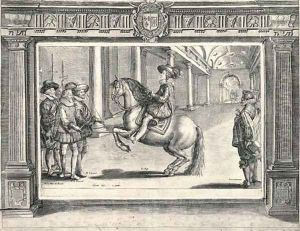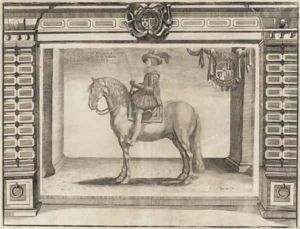Antoine De Pluvinel Paintings
Antoine de Pluvinel was not an artist in the conventional sense of painters or sculptors but was an influential figure in the art of classical dressage and the Renaissance culture of horsemanship. Born in 1552 in Crest, France, he was among the most distinguished riding masters of his time and is often remembered for his contributions to the development of dressage.
In his early years, Pluvinel traveled to Italy, which was a common practice among the European nobility and aspiring courtiers of the period, to complete his education. There, he became a student of Giovanni Battista Pignatelli, a revered horseman at the Neapolitan riding academy. Under Pignatelli's tutelage, Pluvinel honed his skills in the equestrian arts, eventually becoming a master of horse riding and training.
After his return to France, Pluvinel's reputation grew, and he gained the patronage of King Henry III. He was appointed as the instructor to the royal pages in 1571 and later served King Henry IV as the écuyer ordinaire, or the ordinary equerry. His close relationship with the French monarchy allowed him to establish the first French riding academy in Paris, the 'Manège Royal', in 1594. This academy became a center of excellence for horsemanship and was frequented by nobility across Europe.
Pluvinel's approach to horse training was revolutionary for his time. He advocated for gentle training methods, emphasizing the importance of understanding the horse's nature and building a harmonious relationship between the horse and rider. This was in contrast to the more dominant and forceful methods prevalent during the era. His philosophy of training was based on the principles of harmony, balance, and refinement.
Antoine de Pluvinel is also known for his written work, 'L'Instruction du Roy en l'exercice de monter à cheval' (The King's Instruction in the Art of Riding), which was published posthumously in 1625. The book contains detailed illustrations by Crispin de Passe the Elder and offers insights into his training methods and the equestrian techniques of the period. These writings have had a lasting impact on the art of classical dressage and have influenced generations of trainers and riders.
Pluvinel's legacy in the realm of classical dressage and his enlightened approach to horse training persist to this day. He passed away in 1620, but his academy continued to operate and his teachings endured, securing his place as a pivotal figure in the history of equestrian arts.

